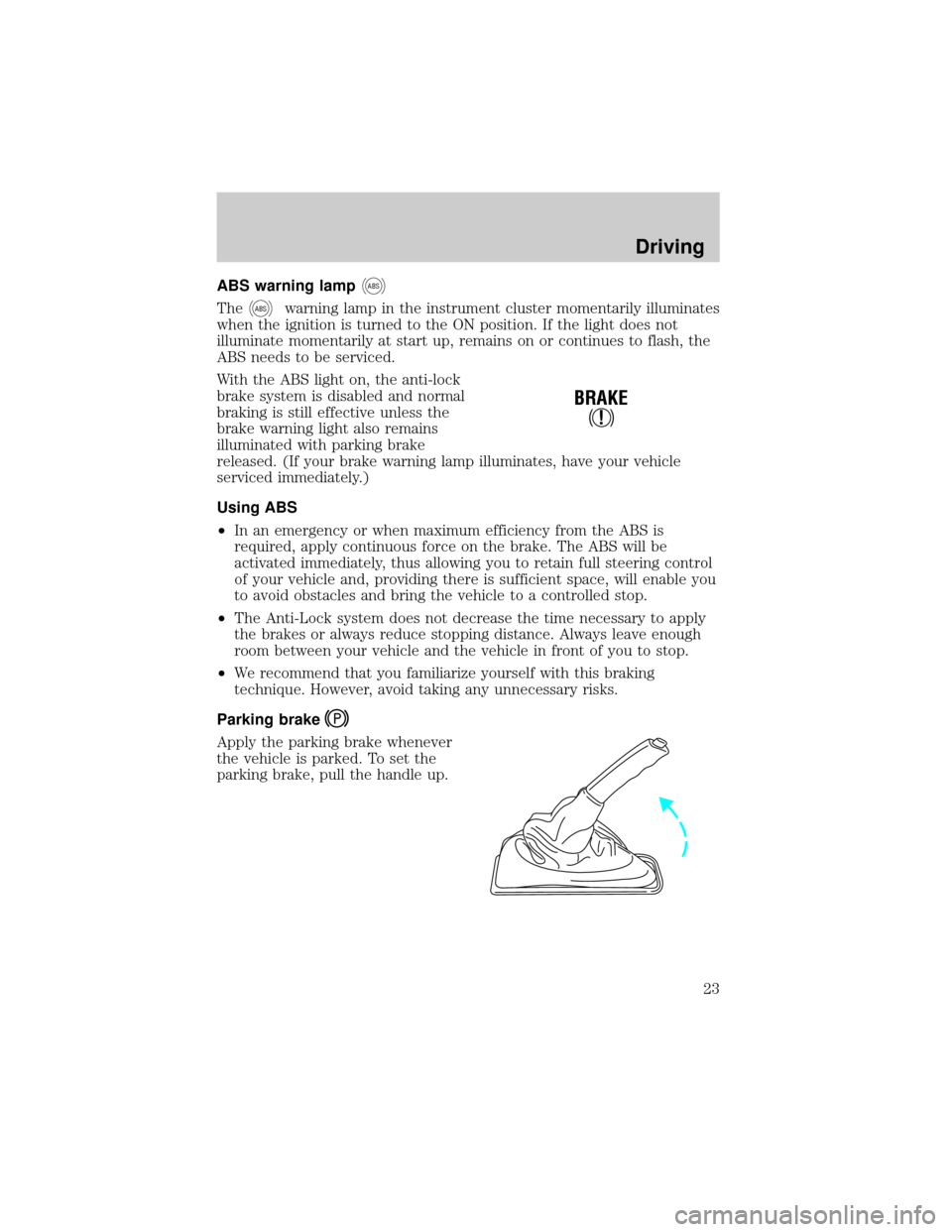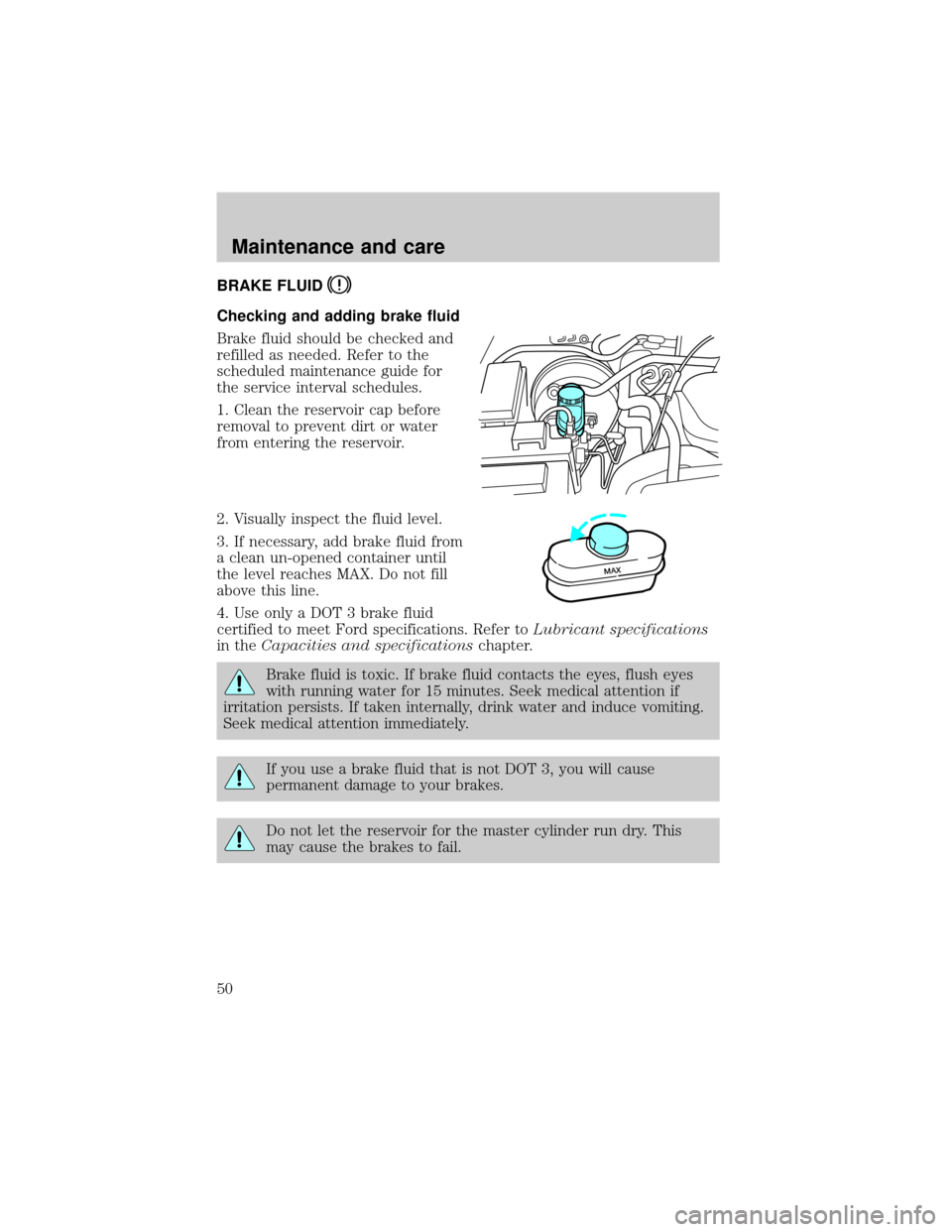2000 FORD POSTAL EXPLORER brakes
[x] Cancel search: brakesPage 22 of 80

BRAKES
Your service brakes are self-adjusting. Refer to the scheduled
maintenance guide for scheduled maintenance.
Occasional brake noise is normal and often does not indicate a
performance concern with the vehicle's brake system. In normal
operation, automotive brake systems may emit occasional or intermittent
squeal or groan noises when the brakes are applied. Such noises are
usually heard during the first few brake applications in the morning;
however, they may be heard at any time while braking and can be
aggravated by environmental conditions such as cold, heat, moisture,
road dust, salt or mud. If a ªmetal-to-metal,º ªcontinuous grindingº or
ªcontinuous squealº sound is present while braking, the brake linings
may be worn-out and should be inspected by a qualified service
technician.
Four-wheel anti-lock brake system (ABS)
This vehicle is equipped with an anti-lock braking system (ABS). A noise
from the hydraulic pump motor and pulsation in the pedal may be
observed during ABS braking events. Pedal pulsation coupled with noise
while braking under panic conditions or on loose gravel, bumps, wet or
snowy roads is normal and indicates proper functioning of the vehicle's
anti-lock brake system. The ABS performs a self-check after you start
the engine and begin to drive away. A brief mechanical noise may be
heard during this test. This is normal. If a malfunction is found, the ABS
warning light will come on. If the vehicle has continuous vibration or
shudder in the steering wheel while braking, the vehicle should be
inspected by a qualified service technician.
The ABS operates by detecting the
onset of wheel lockup during brake
applications and compensates for
this tendency. The wheels are
prevented from locking even when
the brakes are firmly applied. The
accompanying illustration depicts
the advantage of an ABS equipped
vehicle (on bottom) to a non-ABS
equipped vehicle (on top) during hard braking with loss of front braking
traction.
Driving
22
Page 23 of 80

ABS warning lampABS
TheABSwarning lamp in the instrument cluster momentarily illuminates
when the ignition is turned to the ON position. If the light does not
illuminate momentarily at start up, remains on or continues to flash, the
ABS needs to be serviced.
With the ABS light on, the anti-lock
brake system is disabled and normal
braking is still effective unless the
brake warning light also remains
illuminated with parking brake
released. (If your brake warning lamp illuminates, have your vehicle
serviced immediately.)
Using ABS
²In an emergency or when maximum efficiency from the ABS is
required, apply continuous force on the brake. The ABS will be
activated immediately, thus allowing you to retain full steering control
of your vehicle and, providing there is sufficient space, will enable you
to avoid obstacles and bring the vehicle to a controlled stop.
²The Anti-Lock system does not decrease the time necessary to apply
the brakes or always reduce stopping distance. Always leave enough
room between your vehicle and the vehicle in front of you to stop.
²We recommend that you familiarize yourself with this braking
technique. However, avoid taking any unnecessary risks.
Parking brake
Apply the parking brake whenever
the vehicle is parked. To set the
parking brake, pull the handle up.
!
BRAKE
Driving
23
Page 24 of 80

The BRAKE warning lamp in the
instrument cluster illuminates and
remains illuminated (when the
ignition is turned ON) until the
parking brake is released.
The parking brake is not recommended to stop a moving vehicle.
However, if the normal brakes fail, the parking brake can be used to stop
your vehicle in an emergency. Since the parking brake applies only the
rear brakes, the vehicle's stopping distance will increase greatly and the
handling of your vehicle will be adversely affected.
Always set the parking brake fully and make sure that the
gearshift is securely latched in P (Park) (automatic
transmission) or in 1 (First) (manual transmission).
Push the control on the end of the
parking brake and push the handle
down to release the brake. Driving
with the parking brake on will cause
the brakes to wear out quickly and
reduce fuel economy.
STEERING
Your vehicle is equipped with power steering. Power steering uses energy
from the engine to help steer the vehicle.
To prevent damage to the power steering pump:
²Never hold the steering wheel to the extreme right or the extreme left
for more than a few seconds when the engine is running.
²Do not operate the vehicle with a low power steering pump fluid level
(below the MIN mark on the reservoir).
If the power steering system breaks down (or if the engine is turned
off), you can steer the vehicle manually, but it takes more effort.
!
BRAKE
Driving
24
Page 26 of 80

Always set the parking brake fully and make sure the gearshift is
latched in P (Park). Turn off the ignition whenever you leave
your vehicle.
If the parking brake is fully released, but the brake warning lamp
remains illuminated, the brakes may not be working properly.
See your dealer or a qualified service technician.
Driving with a 5±speed automatic transmission
Understanding gearshift positions
Hold the brake pedal down while you move the gearshift lever
from P (Park) to another position. If you do not hold the brake
pedal down, your vehicle may move unexpectedly and injure someone.
P (Park)
To put your vehicle in gear, start the engine, depress the brake pedal,
then move gearshift lever out of P (Park).
Always come to a complete stop
before shifting into P (Park). Make
sure the gearshift lever is securely
latched in P (Park). This position
locks the transmission and prevents
the rear wheels from turning.
Always set the parking brake fully and make sure the gearshift is
latched in P (Park). Turn off the ignition whenever you leave
your vehicle.
R (Reverse)
With the gearshift in R (Reverse),
the vehicle will move backward.
Always come to a complete stop
before shifting into and out of R
(Reverse).
Driving
26
Page 50 of 80

BRAKE FLUID
Checking and adding brake fluid
Brake fluid should be checked and
refilled as needed. Refer to the
scheduled maintenance guide for
the service interval schedules.
1. Clean the reservoir cap before
removal to prevent dirt or water
from entering the reservoir.
2. Visually inspect the fluid level.
3. If necessary, add brake fluid from
a clean un-opened container until
the level reaches MAX. Do not fill
above this line.
4. Use only a DOT 3 brake fluid
certified to meet Ford specifications. Refer toLubricant specifications
in theCapacities and specificationschapter.
Brake fluid is toxic. If brake fluid contacts the eyes, flush eyes
with running water for 15 minutes. Seek medical attention if
irritation persists. If taken internally, drink water and induce vomiting.
Seek medical attention immediately.
If you use a brake fluid that is not DOT 3, you will cause
permanent damage to your brakes.
Do not let the reservoir for the master cylinder run dry. This
may cause the brakes to fail.
MAX
Maintenance and care
50
Page 76 of 80

Air cleaner filter .........................72
Antifreeze
(see Engine coolant) ..................51
Anti-lock brake system
(see Brakes) ...........................22,23
Automatic transmission
driving an automatic
overdrive ...................................26
fluid, adding ..............................56
fluid, checking ..........................56
fluid, refill capacities ................72
fluid, specification ....................74
Axle
lubricant specifications .......73,74
refill capacities ..........................72
Battery .........................................59
acid, treating emergencies .......59
charging system warning light ..9
jumping a disabled battery ......37
maintenance-free ......................59
replacement, specifications .....72
servicing ....................................59
voltage gauge ............................11
Brakes ..........................................22
anti-lock ................................22,23
anti-lock brake system
(ABS) warning light ..............8,23
brake warning light ....................7
fluid, checking and adding ......50
fluid, refill capacities ................72
fluid, specifications ..............73,74
lubricant specifications .......73,74
shift interlock ............................25
Break-in period .............................3
Capacities for refilling fluids ......72
Coolant
checking and adding ................51
refill capacities .....................55,72
specifications .......................73,74
Dipstick
automatic transmission fluid ...56
engine oil ...................................48Doors
lubricant specifications ............73
Driveline universal
joint and slip yoke ......................58
Emergencies, roadside
jump-starting ............................37
Emission control system ............70
Engine ..........................................74
check engine/service engine
soon light ....................................6
coolant .......................................51
idle speed control .....................59
lubrication specifications ....73,74
refill capacities ..........................72
service points ............................47
starting after a collision ...........29
Engine oil ....................................48
checking and adding ................48
dipstick ......................................48
filter, specifications .............49,72
recommendations .....................49
refill capacities ..........................72
specifications .......................73,74
Exhaust fumes ............................20
Fluid capacities ...........................72
Fuel ..............................................65
cap .............................................69
capacity .....................................72
choosing the right fuel .............67
detergent in fuel .......................68
filling your
vehicle with fuel ..................65,69
filter, specifications .............70,72
fuel pump shut-off switch .......29
gauge .........................................12
octane rating ........................68,74
quality ........................................68
running out of fuel ...................69
safety information relating
to automotive fuels ..................65
Fuses .......................................29,30
Gas cap (see Fuel cap) ..............69
Index
76
Page 77 of 80

Gauges ...........................................9
battery voltage gauge ...............11
engine coolant
temperature gauge ...................10
engine oil pressure gauge ........11
fuel gauge ..................................12
odometer ...................................10
speedometer ...............................9
trip odometer ............................11
Headlamps ...................................13
flash to pass ..............................14
high beam ..............................8,13
turning on and off ....................13
Ignition ....................................14,74
Inspection/maintenance (I/M)
testing ..........................................71
Instrument panel
cluster ..........................................6
lighting up
panel and interior .....................13
Jump-starting your vehicle ........37
Keys
positions of the ignition ...........14
Lamps
cargo lamps ...............................13
headlamps .................................13
headlamps, flash to pass ..........14
instrument panel, dimming .....13
Lane change indicator
(see Turn signal) ........................16
Lights, warning and indicator ......6
anti-lock brakes (ABS) .........8,23
brake ............................................7
charging system ..........................9
high beam ...................................8
overdrive off ................................8
safety belt ...................................7
service engine soon ....................6
turn signal indicator ...................8
Lubricant specifications ........73,74
Manual transmission
fluid capacities ..........................72lubricant specifications ............74
Motorcraft parts .....................70,72
Octane rating ..............................68
Odometer .....................................10
Oil (see Engine oil) ....................48
Overdrive .....................................16
Parking brake ..............................23
Parts (see Motorcraft parts) ......72
Power distribution box
(see Fuses) .................................32
Power steering ............................24
fluid, checking and adding ......56
fluid, refill capacity ..................72
fluid, specifications ..............73,74
Relays .....................................29,34
Safety defects, reporting ............75
Safety restraints
warning light and chime .........7,9
Servicing your vehicle ................46
Spark plugs, specifications ....72,74
Special notice ................................3
utility-type vehicles ....................3
Specification chart,
lubricants ................................73,74
Speedometer .................................9
Starting your vehicle .............17,19
jump starting ............................37
Steering wheel
tilting .........................................15
Tires ..............................35,61,62,63
changing ....................................35
checking the pressure ..............63
replacing ....................................64
rotating ......................................63
snow tires and chains ..............64
tire grades .................................62
treadwear ..................................62
Towing .........................................63
wrecker ......................................43
Transmission ...............................25
fluid, checking and adding
(automatic) ...............................56
Index
77